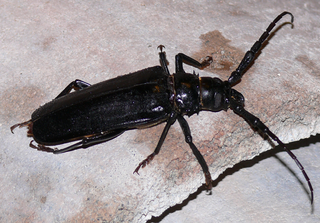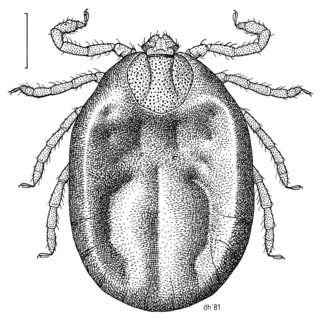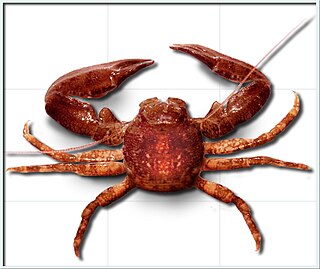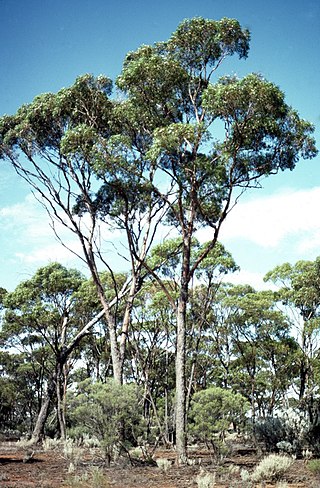
Paratrechina is one of seven ant genera in the Prenolepis genus-group from the subfamily Formicinae. Six species are included in Paratrechina; one of which, the longhorn crazy ant, is a widespread, pantropical pest.

The Luzon scops owl or the Luzon highland scops owl is a species of scops owl endemic to Luzon, Philippines. Not to be confused with the Philippine scops owl, sometimes referred to as the Luzon lowland scops owl, which is a more common species that shares the same range. The Luzon scops owl, however, is smaller and inhabits higher altitudes than its lowland relative.

Derobrachus is a genus of beetles in the Cerambycidae. It contains the following species:

Bifrenaria longicornis is a species of orchid.

Haemaphysalis longicornis, the Asian longhorned tick, longhorned tick, bush tick, Asian tick, or cattle tick, is a parasitic arachnid belonging to the tick family Ixodidae. The Asian longhorned tick is a known livestock pest, especially in New Zealand, and can transmit a disease called theileriosis to cattle but not to humans. However, the tick has been associated with several other tickborne diseases in humans.

Pisidia longicornis, the long-clawed porcelain crab, is a species of porcelain crab that lives in the north-eastern Atlantic Ocean. It varies from reddish to white, and grows to a carapace width of 1 cm (0.4 in). It was first named by Carl Linnaeus in 1767, although the etymology remains unclear.

The longhorn crazy ant, also known as the black crazy ant, is a species of small Formicine ant. These ants are commonly called "crazy ants" because instead of following straight lines, they dash around erratically. They have a broad distribution, including much of the tropics and subtropics, and are also found in buildings in more temperate regions, making them one of the most widespread ant species in the world. This species, as well as all others in the ant subfamily Formicinae, cannot sting. However, this species can fire/shoot a formic acid spray from its abdomen when under attack by other insects or attacking other insects. When the longhorn crazy ant bends its abdomen while aiming at an enemy insect, it is typically shooting its hard-to-see acid.
Copelatus longicornis is a species of diving beetle. It is part of the genus Copelatus in the subfamily Copelatinae of the family Dytiscidae. It was described by Sharp in 1882.

Astathini is a tribe of longhorn beetles of the subfamily Lamiinae. It was described by Thomson in 1864.
Momisis aegrota is a species of beetle in the family Cerambycidae. It was described by Pascoe in 1867. It is known from Indonesia.
Momisis borneana is a species of beetle in the family Cerambycidae. It was described by Vives and Heffern in 2012.
Momisis nicobarica is a species of beetle in the family Cerambycidae. It was described by Gardner in 1936. It is known from the Nicobar Islands.
Momisis singularis is a species of beetle in the family Cerambycidae. It was described by Coenraad Ritsema in 1888. It is known from Sumatra.
Momisis submonticola is a species of beetle in the family Cerambycidae. It was described by Breuning in 1968. It is known from China and Laos.

Pogonognathellus longicornis is a common species of springtail present in Europe.

Eucalyptus longicornis, commonly known as red morrel, morryl, poot or pu, is a species of large tree that is endemic to the south-west of Western Australia. It has rough, fibrous, fissured bark on the trunk, smooth greyish bark above, flower buds in groups of seven or more, white flowers and shortened spherical fruit.
Obereopsis longicornis is a species of beetle in the family Cerambycidae. It was described by Hintz in 1919.

Spilomyia longicornis is a species of syrphid fly, also known as a flower fly or hoverfly, in the family Syrphidae. Although the appearance of S. longicornis is remarkably similar to a vespid wasp, it is a fly and cannot sting. It occurs in North America, east of the Rocky Mountains.
Diabrotica longicornis is a species of skeletonizing leaf beetle in the family Chrysomelidae. It is found in Central America and North America.

Myrabolia is the only genus in the beetle family Myraboliidae in the superfamily Cucujoidea. It has about 13 species, found in Australia. Adults and possibly larvae live under the bark of Eucalyptus trees.











